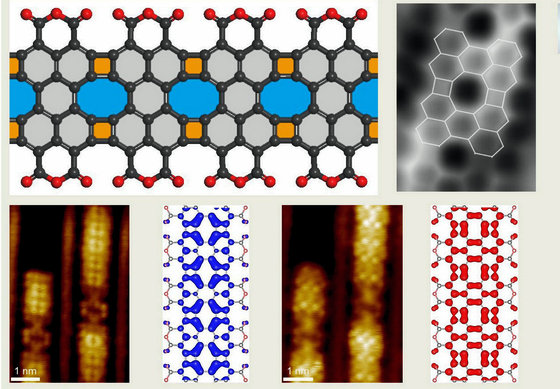Professor Dingyong Zhong’s research group published an academic paper on Nature Communications: Graphene-like nanoribbons periodically embedded with four- and eight-membered rings
Graphene, a two-dimensional single-layer carbon foil, has attracted much attention due to its unique structure and electronic properties. However, the zero-band gap characteristic of graphene limits its application in electronic devices at some extent. Graphene nanoribbons (GNRs), defined as nanometerwide strips of graphene, can open the band gap for the lateral quantum confinement. GNRs have tunable electronic properties determined by different width and edge structure, making it promising candidates for next-generation semiconductors. Recently, Professor Dingyong Zhong’s research group from School of Physics and State Key Laboratory for Optoelectronic Materials and Technologies (OEMT) at Sun Yat-sen University (SYSU) successfully fabricated a new type of graphene-like nanoribbons comprising four- and eight-membered carbon rings. The research results were published on Nature Communications (Nature Communications, DOI: 10.1038/ncomms14924).

(Top left) Diagrammatic sketch of graphene-like nanoribbon embedded with four- and eight-membered rings; (Top right) High-resolution AFM image of nanoribbon resolving four- and eight-membered rings; (Bottom) The highest occupied and lowest unoccupied ribbon states of graphene-like nanoribbons at different bias voltages.
The electronic and magnetic properties of GNRs, such as band gap and spin-polarized edge states, can be readily modulated at nanoscale by precisely controlling the edge structure and width, chemical doping and formation of heterojunctions. Embedding non-hexagonal rings into sp2-hybridized carbon networks is also considered a promising strategy to enrich the family of low-dimensional graphenic structures. However, non-hexagonal rings are energetically unstable compared to the hexagonal counterparts, making it challenging to embed non-hexagonal rings into carbon-based nanostructures in a controllable manner. The authors designed the precursor molecules and utilized the molecular constraint to protect the anhydride groups to obtain graphene-like nanoribbons with periodically embedded four- and eight-membered rings. The scanning tunneling microscopy and atomic force microscopy study revealed that four- and eight-membered rings are formed between adjacent perylene backbones with a planar configuration. The nonhexagonal rings as a topological modification markedly change the electronic properties of the nanoribbons. Undoubtedly, introducing non-hexagonal carbon rings can be an effective engineering approach to modulate the electronic properties of carbon-based nanostructures for achieving desired functionalities.
Meizhuang Liu, a PhD student from School of Physics, SYSU, is the first author of the paper. This work is cooperated with teams of Professor Xiaohui Qiu from National Center for Nanoscience and Technology and Professor Jiaobing Wang from School of Chemistry, SYSU, and Professor Yue Zheng from School of Physics, SYSU.
This research was supported by the grants of NSFC, OEMT, and SYSU, and the computation part of the work was supported by National Supercomputer Center in Guangzhou.
Link to the paper: http://www.nature.com/articles/ncomms14924
